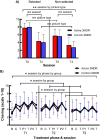Craving on the move: targeting smoking memories with a novel 3MDR-smoking cessation protocol
- PMID: 39720426
- PMCID: PMC11666516
- DOI: 10.3389/fpsyt.2024.1398027
Craving on the move: targeting smoking memories with a novel 3MDR-smoking cessation protocol
Abstract
Introduction: Improved effectiveness and treatment adherence is needed in smoking cessation (SC) therapies. Another important challenge is to disrupt maladaptive drug-related memories. To achieve these goals, we developed a novel treatment strategy on the basis of motion-assisted memory desensitization and reprocessing (3MDR).
Methods: In this study, the added effect of a distractor task following memory recall during a newly designed 3-day SC version of 3MDR (3MDR-SC) protocol on reducing smoking cue-elicited craving was investigated in abstinent chronic smokers. Chronic smokers were randomly allocated to an active 3MDR-SC group (receiving 3MDR-SC with a working memory distractor task) (n = 42) or a control 3MDR-SC group (receiving 3MDR-SC with a non-distracting task) (n = 39). Smoking cue-induced craving and physiological measures were assessed at baseline (T0) and 1 day after the intervention (T4), and smoking behavior was measured at T0 and 2-week (FU1) and 3-month (FU2) follow-up.
Results: Significant decreases in cue-induced craving from T0 to T4 and daily cigarette use from T0 to FU1 and FU2 were observed but not differ between the two experimental groups. Cue-induced changes in heart-rate variability and skin conductance, which did not differ from T0 to T4, and relapse at FU2 were also not different between groups. Dropout rate during intervention was 2.5%.
Conclusions: The 3-day 3MDR-SC intervention resulted in a reduction in cue-induced craving and smoking behavior and showed very good treatment adherence. There was no added effect of the distractor task on 3MDR-SC efficacy. Further studies, including a treatment as usual control, are needed to confirm 3MDR-SC as an effective SC therapy.
Keywords: EMDR; craving; cue exposure; memory reconsolidation; smoking; smoking cessation; tobacco use disorder; working memory.
Copyright © 2024 Koomen, Kaag, Jongenelen, Wouters, van Marle, van den Heuvel, van der Werf and De Vries.
Conflict of interest statement
The authors declare that the research was conducted in the absence of any commercial or financial relationships that could be construed as a potential conflict of interest.
Figures




References
-
- World Health Organization . WHO reports on the global tobacco epidemic 2021: addressing new and emerging products. Geneva: World Health Organization; (2021).
-
- European Commission . Tobacco (2020). Available online at: https://health.ec.europa.eu/tobacco/overview_en (Accessed May the 24th, 2023).
-
- Chavannes NH, Meijer E, Wind L, van de Graaf RC, Rietbergen C, Croes EA. Richtlijn behandeling van tabaksverslaving en stoppen met roken ondersteuning (herziening). Nederlands tijdschrift voor geneeskunde. (2017) 161:D1394. https://www.trimbos.nl/aanbod/webwinkel/af1580-richtlijn-behandeling-van.... - PubMed
LinkOut - more resources
Full Text Sources

